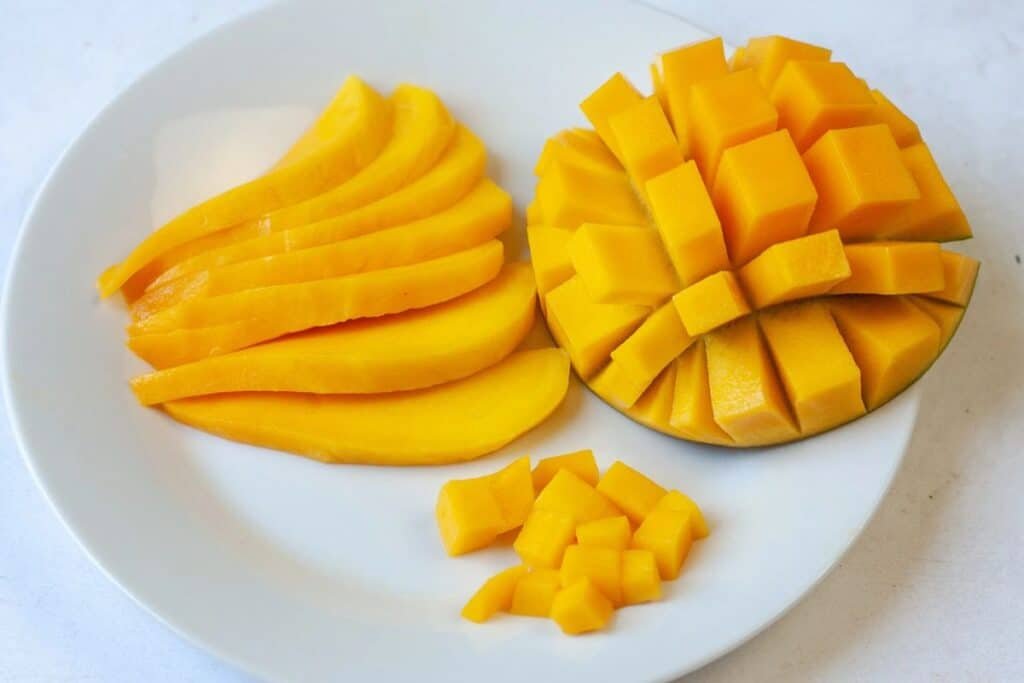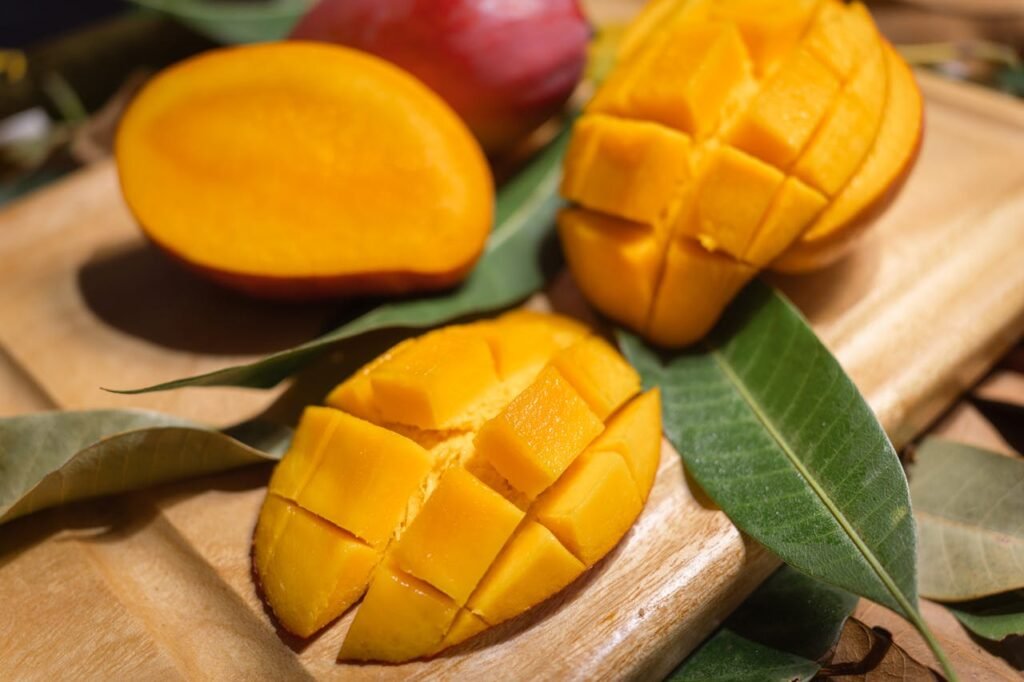Cutting a mango doesn’t have to be difficult if you know how to cut a mango with a knife. Whether you prefer bite-sized pieces or elegant slices, the right technique makes all the difference. In this guide, we’ll show you how to cut a mango into cubes for easy snacking and how to cut a mango into slices for serving.
mango cutting tricks: how to cut a mango into cubes and how to cut a mango into slices

A ripe mango is a tasty treat. However, cutting it can be tricky if you don’t know how to do it. This simple guide will help you learn how to cut a mango with a knife like a pro! Use a sharp knife and a strong cutting board. You will see how to safely cut around the pit of the mango to reach the sweet fruit inside. Get ready to enjoy this tropical fruit in all its goodness!
“This article contains affiliate links. I might get commissions from those links if you click through the link and finalize a purchase. Please read Disclosure section for more information.”
Key Highlights
- Our step-by-step instructions will help you slice up a mango like a pro.
- We’ll guide you through how to choose the right mango, how to tell when it’s at its peak ripeness and what tools to use.
- Take a look at other recipe ideas that incorporate your perfectly cut mango, including salsas, smoothies and more.
- Find out how to keep your cut mango so you can eat it later and get answers to common questions.
History of Mango
The mango, or Mangifera indica, is native to South Asia, and specifically India and Myanmar. They have a history that spans over four thousand years, being one of the oldest cultivated fruits worldwide. In many countries, the fruit is a symbol of love, fertility, and even immortality; its cultural significance is pronounced.
Through trade routes and exploration, mangoes were spread to various parts of the world. In the sixteenth century Portuguese explorers helped to extend the cultivation of mango to Africa and South America. Eventually, mangoes made their way to North America and Australia.
Today mangoes are harvested in many tropical and subtropical areas around the world. Depending on its variety, they are all sorts of different shapes, sizes, and colors. Different types of mango flavors are available. Mango is a popular fruit due to its sweet, juicy flesh, eaten fresh or blended into smoothies, salads, desserts, chutneys and even used as flavoring in beverages. Apart from being a treat to the tongue, mango is known for their rich nutritional profile packed with vitamins A, C and dietary fiber.
Understanding Mangos

They are a well-liked tropical fruit with sugary and juicy pulp. Originating in South Asia, there are many varieties, which differ in flavor, color and odor.
You can find popular types like Tommy Atkins and smaller types like Ataulfo. Mangos add a colorful and flavorful element to a wide variety of dishes. Understanding the different types of mangos, and how to identify them when they are ripe, will help make your cooking even better.
Identifying Different Types of Mangos
When you go into a grocery store, you might see many types of mangos. Each type looks different. There are many varieties of mangos, but only a few are available in stores outside their growing regions.
The Tommy Atkins mango is easy to spot. Its skin has a red blush, it’s firm and its flavor is mild. In contrast, the Ataulfo mango, or Honey mango, is plumper and golden-yellow.
Other popular kinds are the Kent mango, praised for its sweet and fragrant taste, and the Keitt mango, which features bright green skin and a sweet, silky texture. Whichever one you do try; a ripe mango is always a treat.
How to Tell if a Mango is Ripe and Ready to Cut
Selecting a perfectly ripe mango is essential for an enjoyable experience. Unlike with some other fruits, the color probably won’t tell you if a mango is ripe. Some ripe mangos may be green, while others can appear red.
To know if a mango is ripe, you can feel it. Gently squeeze the mango. A ripe mango, like a ripe avocado or peach, will yield a bit when you press it. Avoid mangos that seem extremely hard; they’re not ripe yet, and don’t buy any that feel too soft, as they’re presumably overripe. If you purchase a mango that is not fully ripe, you can aid it in ripening quicker. All you have to do is put the mango in a paper bag at room temperature for a couple of days.
Preparing to Cut a Mango with A Knife
Before talk about how to cut a mango into cubes or how to cut a mango into slices, make sure you have the proper tools. It’s also good to know tips for safety. Cutting a mango isn’t too difficult, but with the right preparation, you can make it a whole lot easier and safer.
With careful preparation and the correct equipment, this task can be a fun activity. Let me show you what you need for an easy, successful mango cutting experience.
Read more- Beginners Mastering How to Cut Pineapple
Necessary Tools and Equipment for Cutting a Mango
Having the right tools is important before learn how to cut a mango into slices. A sharp knife helps you make clean cuts. A small paring knife is good for working around the pit and small areas.
A solid cutting board gives you a safe and steady place to work. It keeps your countertops safe and stops the mango from slipping while you cut.
Also, if you want to peel the skin off before cutting, a vegetable peeler can be helpful.
Safety Tips Before You Begin Digging How to Cut a Mango with a Knife
Working with a sharp knife needs careful attention. Before you start cutting, make sure your cutting board is steady and will not move. You can place a damp paper towel or a non-slip mat under it for better grip.
When you use a sharp knife or a paring knife, always cut away from your body. Keep your fingers away from the blade. Remember to curl your fingers into a “claw” grip. This will help guide the knife and keep your fingertips safe.
After you finish cutting, wash your knife and cutting board right away. This helps stop bacteria from sticking around and keeps your kitchen clean and safe. That’s the basic rule how to cut a mango with a knife.
Step-by-Step Guide to Cutting a Mango into Cubes
Now that you are ready, let’s cut that mango! We will show you easy steps to get perfect slices. Whether you are a beginner or just need a quick reminder, our guides make it simple to enjoy this fruit.
Get ready to enjoy the sweet tropical taste!
Step 1: Washing and Drying Your Mango
Before you cut your fresh mango, start by washing it well under cool running water. Rub the surface gently to get rid of any dirt or bits on it. Even if you will peel the mango, washing the skin is important. This stops any bad stuff from getting onto the flesh when you cut it.
After washing, use a clean paper towel to dry the mango. This will help you hold the mango better and keep it from slipping.
A clean and dry mango is much easier to work with, which makes cutting it quicker and more fun. Also, washing your fruit is a good habit for food safety!
Step 2: Finding the Pit and Orienting the Mango
A mango has a flat, oval-shaped pit inside. To find the pit, hold the mango upright and look at it closely. In most cases, the side that pits along is the longer side of the mango. You may be able to see that the top of the mango is slightly narrower than the bottom. Once you view the side of the pit, you can begin making your first cut.
Place the mango on the cutting board so that the pit runs up and down, the top of the mango facing away from you. Grip the mango tightly at the stem end and keep your fingers out from between the knife and the fruit.
Having a firm grip is important for making clean and precise cuts. Take a moment to adjust your hand position so you feel comfortable and in control.
Step 3: Slicing the Sides (Cheeks) Off the Mango
- Use a sharp knife to carefully slice the sides of the mango.
- Put the mango upright on your cutting board.
- Cut about half an inch away from the pit and slice straight down.
- Do the same on the other side to get two mango halves.
- Next, make crosswise cuts in the mango cheek to create mango chunks or cubes.
- The ripe mango flesh should come off the skin easily.
- This way, you will have all the juicy goodness for your mango recipes.
Step 4: Scoring and Scooping or Peeling the Cheeks
Take one mango cheek and put it cut side down on your cutting board. Use your knife to carefully score the flesh of the mango both lengthwise and crosswise. Make a grid pattern, but don’t cut through the skin.
Now, you can scoop out the cut segments with a spoon. For a fun look, you can gently push the mango piece from the bottom to turn it “inside out.” This makes it look like a hedgehog. If you want to take off the skin completely, you can use a paring knife or vegetable peeler.
Do the same with the other mango cheek. This way, you can enjoy tasty, bite-sized pieces of mango.
Step 5: Cutting Remaining Flesh Around the Pit
Don’t throw away the middle part of the mango just yet! It might look like there’s not much fruit left, but you can often get a good amount of tasty mango flesh from this area.
Place the middle section flat on your cutting board. Take your paring knife and carefully cut around the pit to remove any leftover mango flesh. You can then slice the mango into smaller pieces or enjoy it whole.
This will help you get the most out of your mango. It reduces waste and boosts flavor.
Creative Ways to Serve and Enjoy Mango

Now that you know how to cut a mango, it’s time to enjoy it! Mangoes are so delicious and can be used in many ways. You can add them to your breakfast bowl, blend them into smoothies, or make tasty desserts.
Let’s look at some recipe ideas that highlight the great taste of this wonderful fruit.
Mango Salsa Recipe
Now that you’ve learned how to cut the mango into cubes, it’s time to eat one! Mangoes are super scrumptious and versatile too. You can toss them into your breakfast bowl, throw them in smoothies or use them to make yummy desserts. Here are some recipe ideas that showcase the superior flavor of this wonderful fruit.
Add something colorful and tasty to your dish — mango salsa It is delicious with grilled fish, chicken, or simply served on its own with tortilla chips. First, peel and cut your ripe mango into small cubes. Then stir them up with some chopped red onion, cilantro, jalapeno (if you want), a splash of lime juice and a bit of salt. You can adapt the recipe to your liking by adding a little bit of bell pepper or your favorite fruit.
Let the salsa sit in the fridge for at least 30 minutes before serving. This allows the flavors to come together nicely.
Mango Smoothie Bowl Inspiration
Start your day with a tropical treat in a bowl! Prepare this delicious mango smoothie bowl. Start by blending a cup of frozen mango chunks with a banana. Throw in some almond or coconut milk and some nut butter of your choice.
Blend that until smooth and creamy. Then you pour the mixture into a bowl. Top it with fresh mango slices, granola, and unsweetened shredded coconut. Enjoy your will set with some other nuts or drizzle of honey that you normally ignored.
The juicy mango, rich coconut, crunchy granola gives you a good variety of textures. This colorful and nutritious breakfast bowl is full of vitamins and healthy fats to give you energy all day long.
Conclusion
In conclusion, cutting a mango is easy and fun. It can make your meals even better. To cut a mango well, you need to know about the types of mangos and how to tell if they are ripe. It’s also important to be safe while cutting. Using the right tools and following simple steps helps you enjoy fresh mango in many ways. You can use it in salsa or smoothie bowls. So, the next time you have a mango, be confident and creative. Enjoy every bit of this tasty fruit!
Frequently Asked Questions
Can Mango Skin Be Eaten?
The skin of a mango is edible and is high in dietary fiber. But that is one reason why most people don’t like it — it is bitter and hard. It’s best to savor the sweet, juicy flesh inside.
How Do You Store Cut Mango?
For cut mango, place the mango pieces in a sealed container and refrigerate. This should last up to 3 days for them. And to keep them for a longer time, spread the mango chunks on a baking sheet lined with parchment paper and freeze. Once they’re frozen, transfer them to a freezer-safe bag. Freezer – they last 6 months or so in the freezer.
What Is the Easiest Way to Cut a Mango with a Knife?
To slice a ripe mango, begin by cutting off two cheeks on either side of the pit. Step Two — Score the Flesh and Spoon it Out Or you can peel the skin and cut it into pieces any way you wish.
Can You Freeze Mango?
Store mango cubes in a sealed container or freezer bag. They will last for 6 months. These mango cubes are perfect for adding to smoothies, desserts or enjoying as a delicious frozen snack.









Pingback: Easy Steps: How to Cut a Pineapple Easily